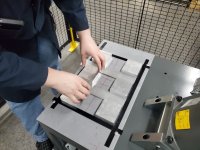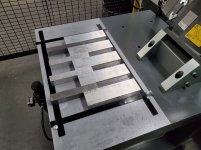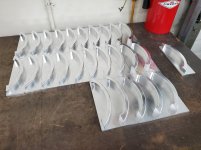Time for an update!
We have been making some steady progress with the robot and machining 1st op's on a variety of parts. No, we still have not made the leap to stacking parts on the material table, but with things progressing in the manner in which they are, it will not be soon before doing so.
Right now Andrew has been able to set up robot fairly quickly. When I say "fairly", it can be perceived as a very subjective term because let's face it, who knows how long it "should" take, right?
Well, according to the applications engineer who did the training, he insinuated it could be the better of a day to get it set up and making parts. Ok, wait....what? That is not what I signed up for, so let's break this down.
When learning to set up the robot for the "first few times", it was taking the better of a day to set up, yes.....absolutely!
Andrew though seems to have the knack for doing this however in very short order!
Once you do a few similar jobs, the gripper selection and array set up on the material staging table gets much easier to understand and adopt for the new job.
So, by comparison, to set up some of the parts he's doing with Wall-E, it might take 45 minutes in one of our VF-2SS machines, whereas with the robot cell, it is taking about an hour to an hour and a half. I can live with that, considering once it's set up, it's running until the staging table is empty and the finished parts table is full. The longest cycle time we've managed from table full to empty has been only 36 minutes, but, it's running through break, it's running through lunch, and more importantly, it's one out of five machines running that is completely unattended.
The table change over time from removing finished parts to setting up blanks is taking him about 60 seconds.
We have experienced a couple of crashes due to our own inexperience. When I say crash, I simply mean a broken end mill that was the result of an improperly seated part in the vise. Fortunately, someone close by heard that awful "SNAP" and the cycle was stopped before any more tools were lost. The part slipped in the gripper due to some gouges in the extruded side of the aluminum material and was placed in the vise off in the "X" axis, resulting in the .500" carb 3flt em trying to slot full diameter .755" deep at 12k rpm and 250ipm. It actually made it 1.5" into the material before it broke, so not too bad.....I guess.
The other blunder was due to the array on the pick up table being off and same as above, way off in the "X" so when profiling it just ripped that part right out of the vise and tossed into the back of the machine. Very glad it did not take out the wireless tool setter on the table.
After those two mishaps we've learned to double check the array dimension in the control, and also, that one set of grippers is not necessarily good for every part.
Here's a close up the grippers we're using on some knobs we're machining.

Another safety feature we've implemented on every job now is to perform a break detect after the rough profiling tool. It adds about 10 seconds to the cycle time, but ensures that if the first tool breaks and no one is around to hear it and stop the machine, all the subsequent tools will not get broken as well as the machine will just stop and alarm out if it detects a deviation on the tool being checked by a tolerance we set in the control.
Time for some more pics!
Below is some 1" x 3.5" cut 3.250" 6061 material waiting to go into the robot cell to be machined into some knobs we make. With a qty of 200pcs on this order, Wall-E is the perfect choice for the 1st op on these parts.

Andrew setting up the blanks on the material staging table. Yes, it looks cumbersome, but before investing in a larger table, we're keeping things simple for now. Once we get good at the simple set ups such as these, the larger ones will be much easier.
For now we are just using some 2" wide strips of aluminum to set the spacing between blanks.

With the spacing set, he simply pulls out the spacer while holding the material.

I did take some video of this part from start to finish with Wall-E putting them in and taking them out of the machine, but like a dope........it was not shot in HD and looked like total crap, so all I have are before and after pictures.
Here are the after pictures of the parts after coming out of the machine, thanks to Wall-E!


Here's a close up view of the same pieces.

This is the finished product after being red anodized.

That's all for tonight, been a long day!
To be continued...............





















